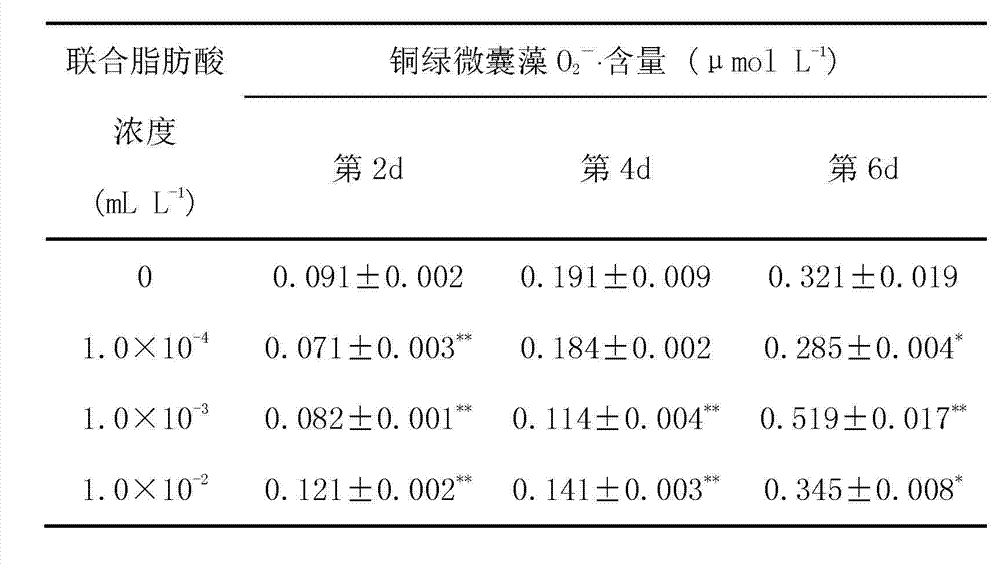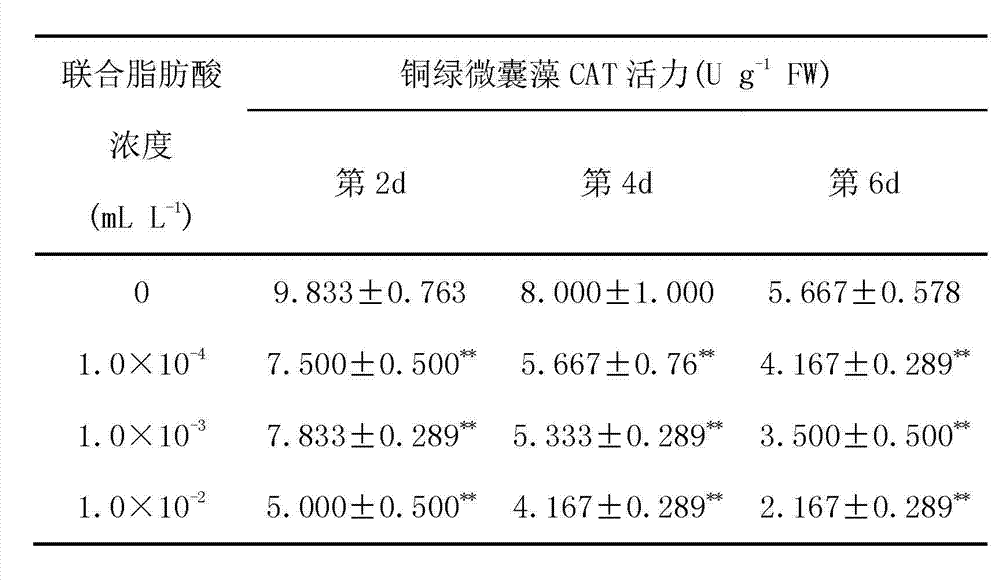Algae inhibitor for verdigris microcystis aeruginosa
A technology of Microcystis aeruginosa and Microcystis green liquid, which is applied in the direction of chemicals, herbicides and algicides, applications, etc. for biological control, and can solve the problems of unfavorable use of algastatic agents, odor, and allelochemicals Problems such as high price
- Summary
- Abstract
- Description
- Claims
- Application Information
AI Technical Summary
Problems solved by technology
Method used
Image
Examples
Embodiment 1
[0043] Pour the algae liquid of Microcystis aeruginosa in the logarithmic growth phase into a 50 mL Erlenmeyer flask, and then pour it into BG-11 medium (refer to the information of freshwater algae species bank for graduate students of aquatic biology in the Chinese Academy of Sciences) to make the algae cells start. The density is 7.0×10 5 per milliliter, the volume is 20 mL. Prepare different concentrations of algastatic agents (the volume ratio of nonanoic acid and linoleic acid is 1:1), nonanoic acid and linoleic acid, and measure their inhibition rate on Microcystis aeruginosa. The results are shown in Table 1, 2, 3 shows:
[0044] Table 1 Inhibition rate of combination of nonanoic acid and linoleic acid against Microcystis aeruginosa (%)
[0045]
[0046] The data in the table are mean±SE (n=3).
[0047] Table 2: Inhibition rate (%) of nonanoic acid to Microcystis aeruginosa
[0048]
[0049] The data in the table are mean±SE (n=3).
[0050] Table 3 Inhibiti...
Embodiment 2
[0059] Pour the algae liquid of Microcystis aeruginosa in the logarithmic growth phase into a 50 mL Erlenmeyer flask, and then pour into the medium to make the initial density of algal cells 7.0×10 5 per milliliter, the volume is 20 mL. Prepare different concentrations of algastatic agents (the volume ratio of nonanoic acid and linoleic acid is 1:1) to measure their effects on the protein content of Microcystis aeruginosa algae liquid, and the results are shown in Table 5: Table 5 Nonanoic acid and Effects of linoleic acid combined on the protein content of Microcystis aeruginosa
[0060]
[0061] The data in the table are mean ± SE (n=3),
[0062] * Compared with the control group in the same period, P** Compared with the control group in the same period, P<0.01
[0063] It can be seen from Table 5 that under the combined action of pelargonic acid and linoleic acid, the protein content of the algae liquid increased with the increase of the concentration, 1.0×10 -2 mL...
Embodiment 3
[0065] Pour the algae liquid of Microcystis aeruginosa in the logarithmic growth phase into a 50 mL Erlenmeyer flask, and then pour into the medium to make the initial density of algal cells 7.0×10 5 per milliliter, the volume is 20 mL. Different concentrations of algastatic agents were prepared (the volume ratio of nonanoic acid and linoleic acid was 1:1) to determine their effects on the nucleic acid content of Microcystis aeruginosa liquid. The results are shown in Table 6: Table 6 Nonanoic acid and Effects of Linoleic Acid on the Nucleic Acid Content of Microcystis aeruginosa Liquid
[0066]
[0067] The data in the table are mean±SE (n=3).
[0068] * Compared with the control group in the same period, P** Compared with the control group in the same period, P<0.01
[0069] Table 6 shows the changes in the nucleic acid content of Microcystis aeruginosa liquid. It can be seen from the table that the nucleic acid content of algae liquid increased gradually with the in...
PUM
 Login to View More
Login to View More Abstract
Description
Claims
Application Information
 Login to View More
Login to View More - R&D
- Intellectual Property
- Life Sciences
- Materials
- Tech Scout
- Unparalleled Data Quality
- Higher Quality Content
- 60% Fewer Hallucinations
Browse by: Latest US Patents, China's latest patents, Technical Efficacy Thesaurus, Application Domain, Technology Topic, Popular Technical Reports.
© 2025 PatSnap. All rights reserved.Legal|Privacy policy|Modern Slavery Act Transparency Statement|Sitemap|About US| Contact US: help@patsnap.com



